I just finished renovating an entire 2-bedroom, 1-bathroom apartment and totally remodeled the kitchen from a U layout to an L layout with an island. Here are some before and after pics and step-by-step pictures showing how I did it.









Here’s how I renovated the apartment step by step:
Removed all doors
The doors were all beat up so I replaced them with new ones.


Removed fixtures



Replaced all outlets with Decora outlets
For the kitchen and bathroom, use 20 amp outlets, otherwise, use 15 amp outlets.


Removed HVAC registers and grills
All HVAC registers were beat up so I replaced them all.


Removed all baseboard
To remove the baseboard, first, cut the caulk using a utility knife. You can also use an oscillating tool.

Then, I like to use a mallet and a special tool that makes it easy to pry the baseboard away from the wall. It has a large surface area to minimize damaging the wall as you pry the baseboard off.

Most of the time, you can reuse the baseboard. But in this case, mine was so beat up that it wasn’t worth it. Plus, for a rental property, it’s better to install a tile baseboard.
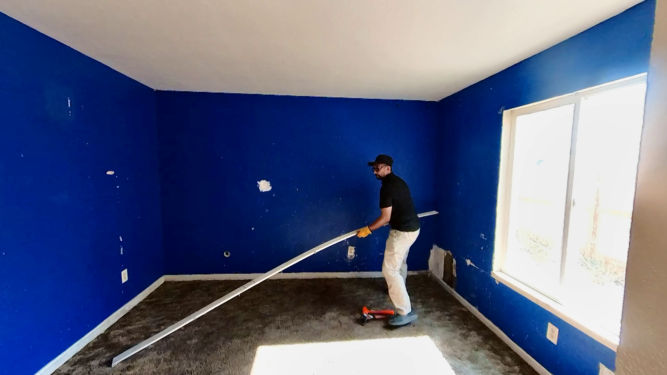
Ran new wiring for a ceiling fan
First, I made holes in the wall and ceiling between studs and joists using a 4″ hole saw. I then inspected the area behind the wall and ceiling to ensure no obstacles were present. It there were obstacles, I could easily patch the holes using the circular cutout pieces.

I then ran yellow romex wiring. Yellow wiring can support 20 amps. I could have used a higher gauge (thinner, lower 15 amp-rated) wire since this is for a ceiling fan in a bedroom.

Where the ceiling fan would go, I cut a rectangular piece of drywall using a small reciprocating saw. I could have used a jigsaw as well. The cut was made in such a way so that I could reuse the piece to patch the ceiling when done.
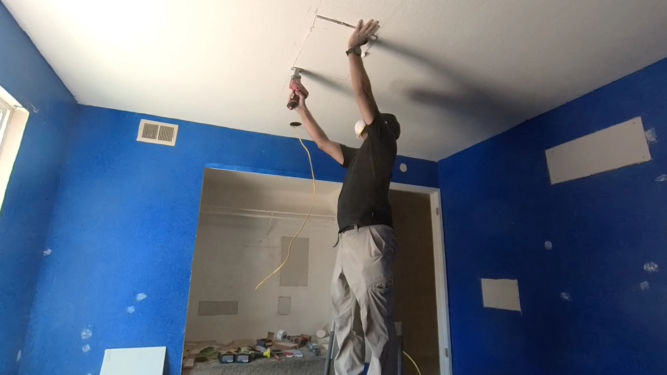
After installing a ceiling fan bracket between joists, I pulled the wiring to the bracket.
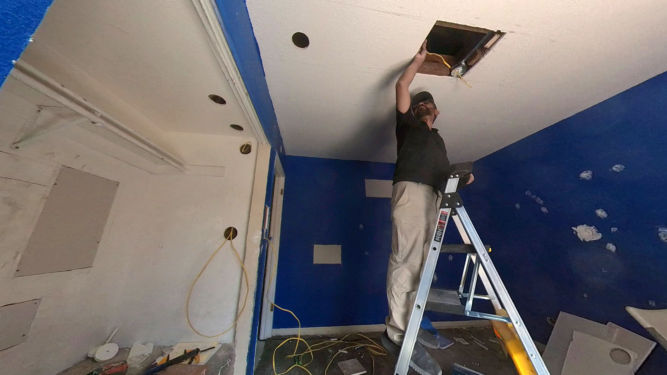
I then wired up the switch…
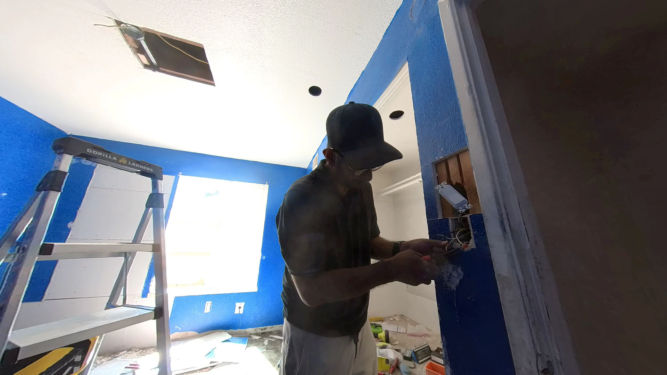
…and patched the ceiling using the existing drywall.

For the circular holes, I patched them using the circular drywall cuts created when making the holes. I screwed a piece of furring strip behind each hole as pictured.

And then screwed the circular drywall cuts to the furring strip.

Demolished the bathroom vanity
The vanity top was made of cultured marble. I just broke it into small pieces using a sledge hammer.

I then cut up the wood vanity using a reciprocating saw and a demolition blade.

I removed the caulk on the wall using a oscillating tool following by an orbital sander.
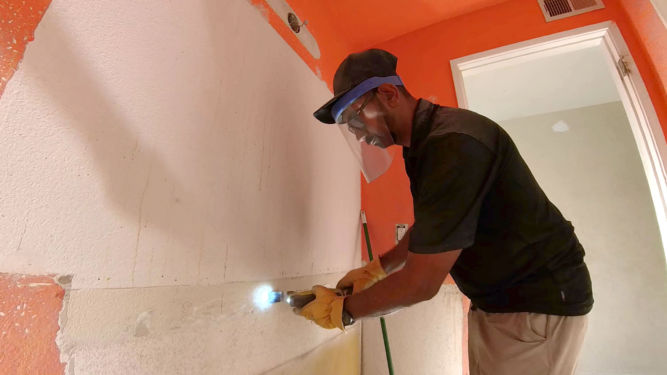
Patched holes in the wall and replaced damaged drywall
In the kids’ bedroom, there were many holes in the wall. Some parts of the wall were patched very poorly. I decided to a large section of drywall. I tried using a drywall cutout tool but it was very noisy and it was hard to cut a straight line.

I ended up just using a reciprocating saw and oscillating tool to cut the drywall.

I screwed in the drywall using drywall screws.

I put mesh tape along the edges of each piece of drywall. This helped hold the drywall mud in place where there were large gaps.

For the drywall mud, I used premixed joint compound so I didn’t have to mess with mixing powdered drywall with water.
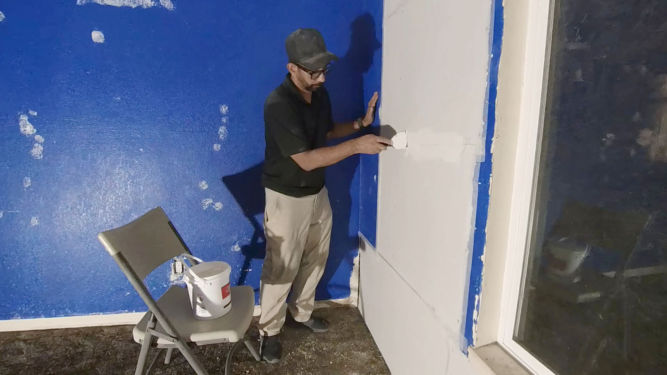
I then used an orbital sander to smoothen the mud. This produced a lot of dust, but that was okay because I was going to remove the carpet and paint the walls afterward.

Demolished the kitchen
To demolish the old kitchen cabinets, I first unscrewed and removed each cabinet door.
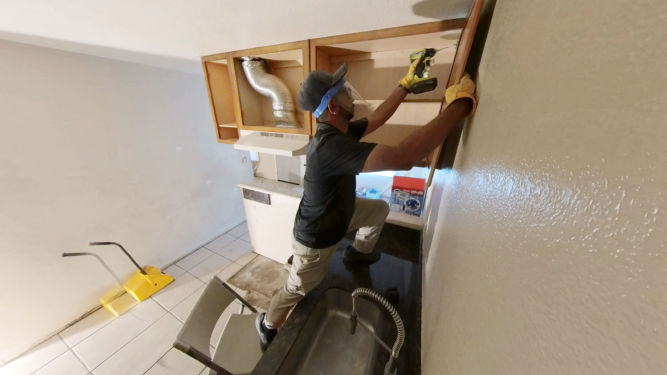
I hated the old kitchen layout. The half wall and ceiling cabinets made the dining and kitchen areas very small.

The ceiling cabinets can easily be removed by unscrewing them from the ceiling and wall.

I used the backyard to temporarily store all the construction debris.

I removed the heavy marble countertop by breaking it up into small pieces using a sledge hammer.

You should definitely wear a full face mask when doing this to prevent small objects hitting your eyes or face.

Just for fun, I used my 24V electric chainsaw to cut up the base cabinets.

After unscrewing some screws that fastened the base cabinets to the wall, I was able to pull out the cabinets.

To remove the pony wall, I drilled a bunch of 4″ holes in it so I could see if there was anything dangerous behind it.

I was then able to demolish it.

The 24V electric chainsaw was handy for quickly cutting some thick pieces of wood.

For safety, I hammered down any nails that were sticking out.

The wall was soggy because there was a small leak that was never detected. I had to cut out the soggy drywall so I could replace it.

Demolished old tile
To remove the old floor tile, I used a jackhammer with a chisel bit. Since there had been a leak in the kitchen, the tiles were easy to remove.

In the living room, however, it was a little harder to remove the tiles.

In general, separating the tile from the floor was easy.

What was difficult was moving the broken tile outside because it was heavy.

I put the broken tile in bags out front.

I first tried removing the thinset mortar using a scraper attachment on my jackhammer. But, that proved slow and very tiring…
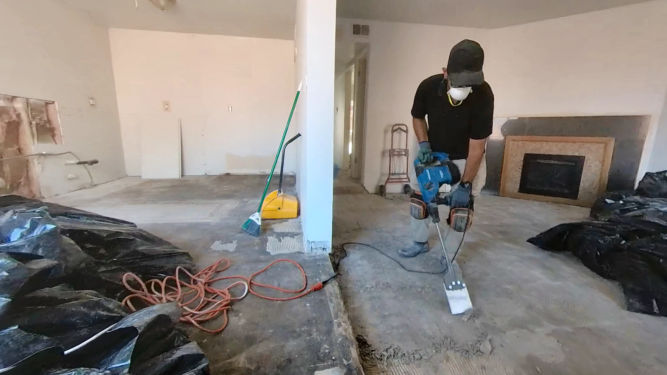
… so I rented a heavy duty jackhammer and cart. This was much easier but still a lot of work. Note to future self: don’t ever do this by yourself. Just pay someone to do it.

Painted the ceiling and walls
I used painter’s plastic to cover large areas like windows. It’s a very thin plastic.

I sprayed glue around the perimeter of the window.

And stuck the plastic to the wall.

I removed excess plastic by trimming it off with a utility knife. Make sure to use a new blade.

I could then just peel off the excess plastic.

I did the same to cover outlets and switches, although I alter realized it would’ve been easier to cover small areas using blue masking tape.
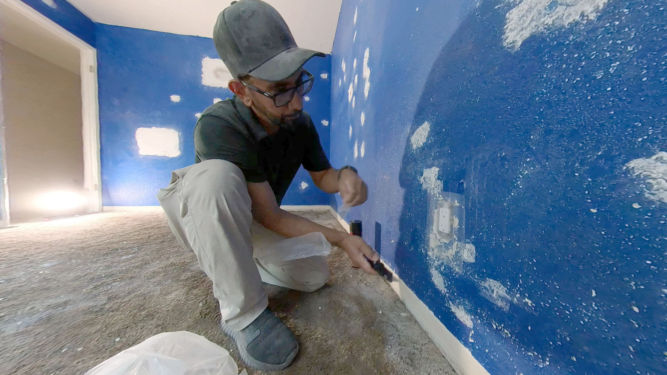

You can then trim the excess tape with a utility knife so when you’re done painting…

…you can just remove the tape.

To paint the walls and ceiling, I used the Graco Magnum X5 Airless Paint Sprayer. Setting it up and cleaning it up was a hassle, but once it was primed and ready to go, it worked very well and made painting very quick and easy with good, even results.
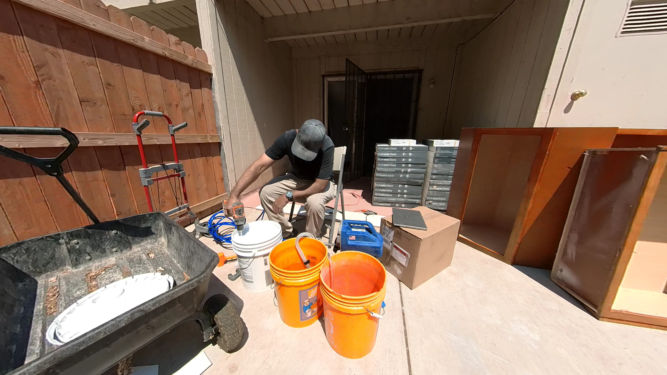
I first painted primer on the colored walls since the colors were dark. I painted two coats.

Try to move quickly to avoid runny paint.

Painting ceilings is easy with a paint sprayer like this.

Once the primer dried, I painted the whole apartment. A fresh coat of paint really does make a big difference by making the place look new and clean.

But spray paint particles can really get on your face and glasses.

Dirty walls suddenly look new again.

Painting ceilings would have really been hard without a paint sprayer.

Removed carpet
Using a utility knife, I cut the carpet in 2 or 3′ sections.

I then rolled it and the underlayment padding up and strapped it from unraveling using duct tape.
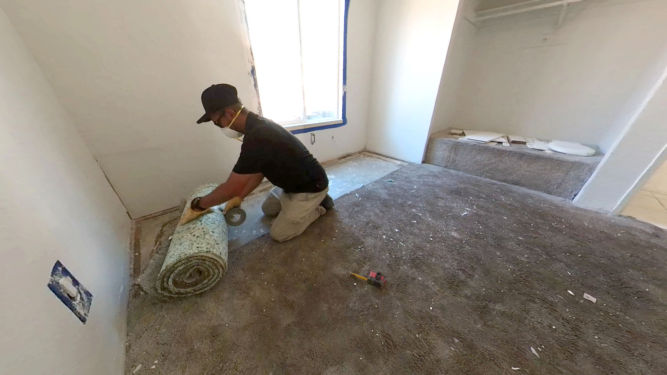
I then removed the tack strip along the perimeter since I was going to install tile over the concrete.

Husky contractor clean-up bags are great for disposing of construction debris.

Using an angle grinder, I trimmed any tacks/nails that were stuck in the concrete.
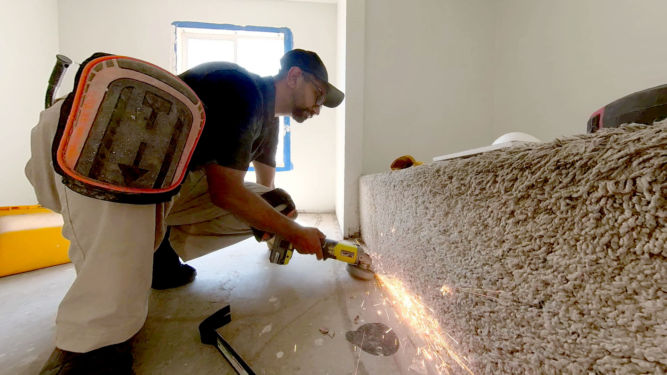
Here’s a close-up.

Replaced all multi-turn water valves with 1/4-turn ones
I hate multi-turn water valves. I paid a plumber to replace them with 1/4-turn valves.

Installed tile
I bought 12″x24″ large tiles.

I paid someone to install the tile. First, they removed the tile around the electric fireplace.

Then they put cement board around the firstplace as backing for the tile.

They scraped the floor to remove any uneven spots from thinset.

They mopped the floor to remove excess dust.

They mixed the thinset and troweled it on the floor before laying down the tile.

I later noticed they were using the wrong type of thinset so I had them use thinset for large format tile (LFT).

For some tile, they’d cut it using a manual tile cutter.


They used little red plastic things to ensure adjacent files were level with each other.
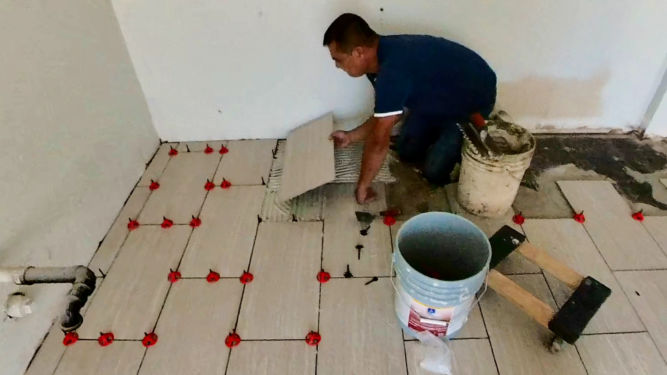

I chose a terracotta color for the fireplace surround tile.


They applied the grout.

Then wiped it off the tile itself.

And mopped off any excess grout.

Patched kitchen wall
Before installing the cabinets, I had to patch the wall where there had been a water leak. I marked the stud locations using a stud finder.

Using a level, I drew lines where the studs were.

Sometimes, I’d cut drywall using a jigsaw.

Other times, I’d cut it by first scoring it using a utility knife…
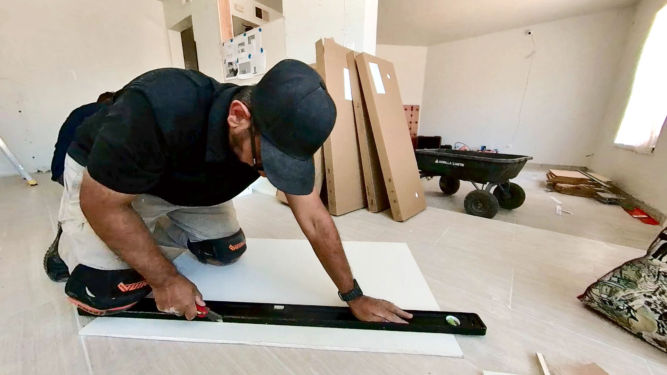
…snapping it…

…and scoring the other side.

It’s actually easier and creates a straight cut with no dust.

I had to screw in some 2x4s to existing studs so I’d have a frame to screw the drywall into.

I dry-fitted the cut drywall panels.

And occasionally I’d have to mark edges that didn’t fit…

…so I could trim them using a rasp.

I screwed the drywall into the studs using drywall screws such that the screw heads would be slightly recessed so they wouldn’t be seen after patching with drywall mud.

I added mesh tape along all seams/joints to hold drywall mud (joint compound).
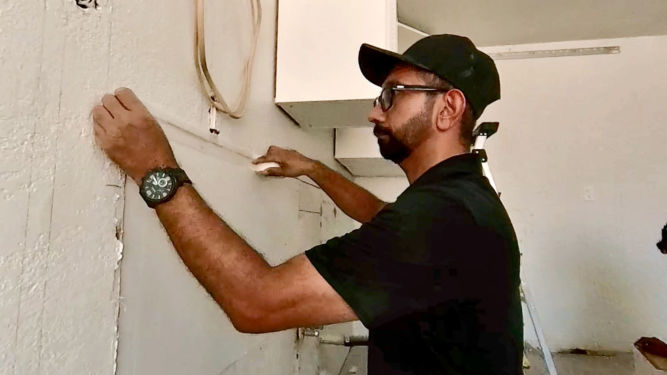
Then I applied joint compound.

Rerouted kitchen exhaust
I had to cut open the ceiling and reroute the exhaust vent.

I removed the old rigid vent.

And installed a flexible vent.

The exhaust went was moved to the wall above where the range would be.

Installed IKEA kitchen cabinets
IKEA delivered the kitchen cabinets.
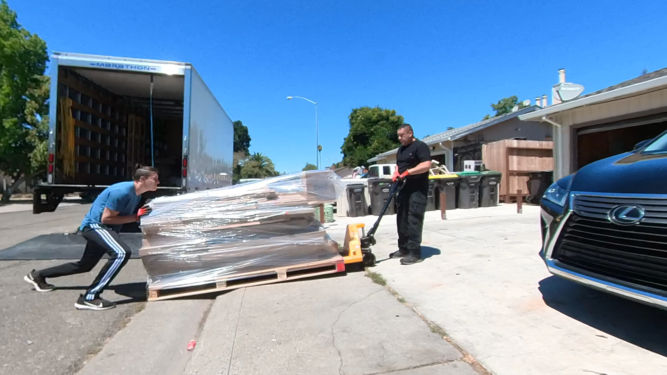
To install the wall cabinets, we had to fasten metal brackets to the wall, sometimes using drywall anchors. We also had to cut some of the brackets using an angle grinder.


IKEA cabinets come flat-packed and must be assembled.

Fastening wall cabinets to the wall is easy because you can hang them on the bracket and adjust their position before finalizing where they’d go.

The base (floor) cabinets/drawers come with short plastic legs. This is good so that if the floor is wet, the wooden cabinets wouldn’t get wet.

I decided to run additional wiring to a new switch to control a new ceiling fan I planned to put in the kitchen.

We cut a hole in one of the wall cabinets where the exhaust vent would go.

All IKEA cabinet boxes are white. For end cabinets werhe a side will be exposed, we screwed a finished panel to the side.

We installed the over-the-range microwave.

And then attached the cabinet doors.

We screwed in the door handles and attached the kickboard.

Installed quartz kitchen countertop
For IKEA kitchen cabinets, I had to cut 3/4″ thick plywood to put on top of the base cabinets. For non-IKEA cabinets, you can use 1/2″ thick plywood.

I screwed the plywood in through the metal holes at the top of the cabinets.

I decided to buy a new range because the old was in very bad condition.

I bought the quartz countertop from Granite Expo and paid them to install it. In the picture below, they cut the quartz and sanded the edges.

Cutting quartz can produce a lot of dust.
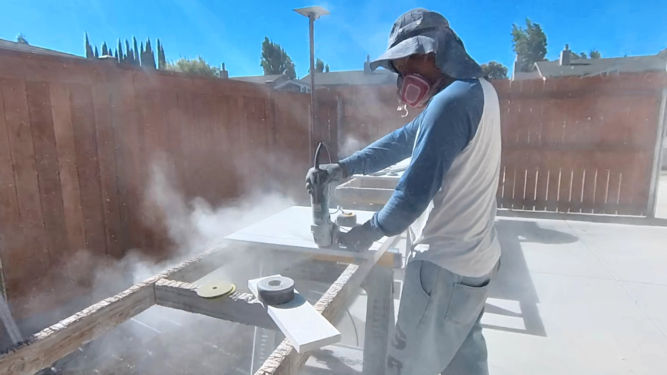
The inside edges were also smoothened.

One guy cut a hole in the plywood for the sink. I decided to go with an undermount sink. The lip of the sink would sit on the plywood but below the countertop. The would ensure the sink would stay in place.

They also made a hole in the countertop for the sink. Like marble, quartz countertops are very heavy.

They put construction adhesive on the plywood before laying down the countertop.
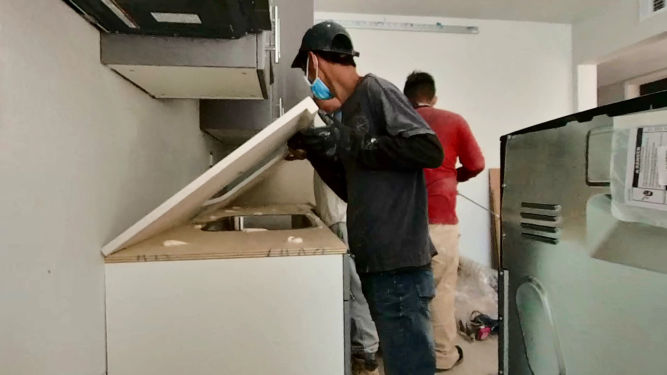
The corner seam between the two adjacent countertop slabs was straight, not diagonal. Getting the two slabs to be perfectly level with each other was tricky. The guy screwed a screw up from under and through the plywood to push up areas of the countertop so it would be level with the adjacent slab. The other guy was applying silicone caulk around the inside edge of the sink.

One of the guys was smoothening and polishing one cut end of the backsplash.

They glued the backsplash to the wall.

They were nice enough to clean up after themselves.

Installed a new range
Unlike other appliances, I had to install the range plug by screwing it to specific terminals on the range.
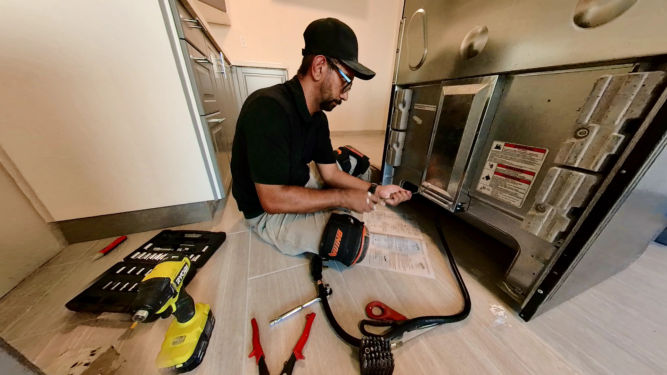
I decided to replace the 220V outlet with a new one. I turned off the circuit breaker first.

Installed kitchen sink plumbing
I first secured the sink to the countertop by turning a large plastic piece. No special tools were required.

I then screwed the hot (left) and cold (right) water supply lines to the new 1/4-turn valves.

I made a bead of plumber’s putty…
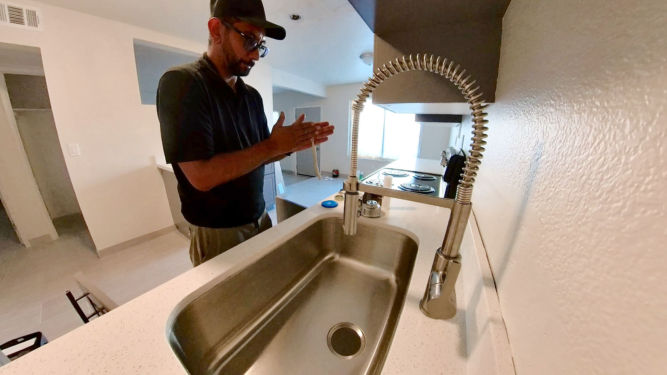
…and put it around the sink hole…

…and then put the sink strainer on it. The plumber’s putty helps prevent leaks.

I then secured the sink strainer by screwing it to a complementary part underneath the sink.

The black PVC drain pipe stuck out too far so I cut it. After installing the garbage disposal, I applied PVC glue around the pipe…

…and inserted a threaded coupling to it.

I then connected the garbage disposal outlet to the drain inlet coming out of the wall. I hate fooling around with PVC so this time, I used flexible p-trap by SimpleDrain. It comes

It’s so much easier to install than PVC p-traps. Instead of screwing on flimsy PVC nuts, SimpleDrain uses an adjustable metal clamp.

This is what the old kitchen looked like.


And this is the new. One of the cabinets was missing when I took this photo. As you can see, remodeling the kitchen with a new layout really makes the kitchen feel bigger.

Replaced kitchen lights
I decided to replace the kitchen and dining room ceiling lights.
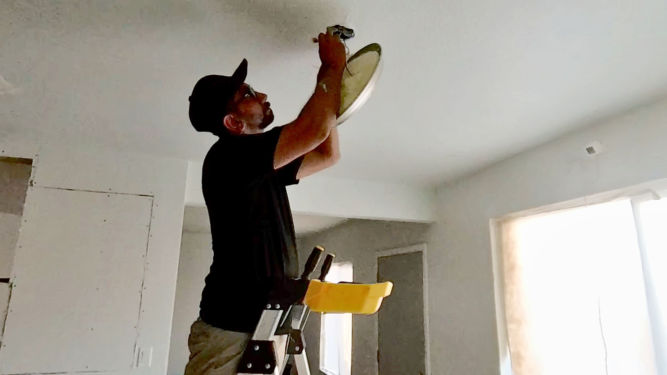


Installed bathroom vanity
I bought a gray vanity to match the gray kitchen cabinets. I had to assemble the vanity.
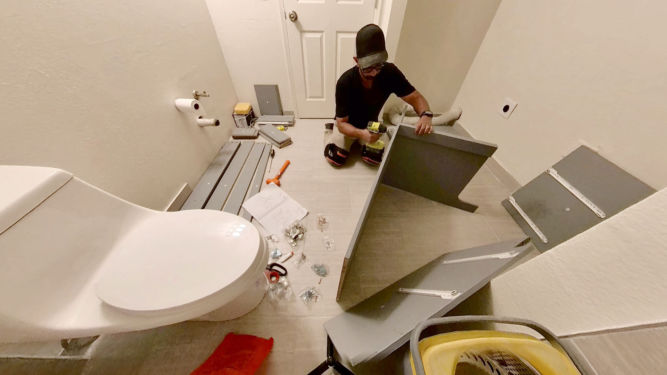

Without the countertop, it was lightweight.


It actually took a long time to assemble. After assembling the frame and installed the 2 doors, I had to assemble 4 drawers.


Once that was done, I could install the heavy countertop by first applying a bead of glue to the top perimeter of the vanity frame…

…and to the wall where the backsplash would go.
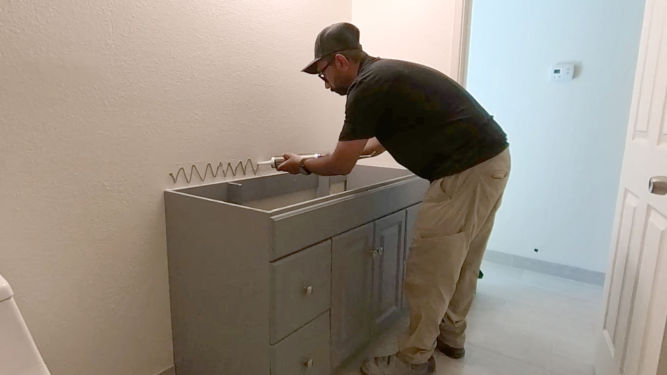
I like this countertop because the sink and backsplash are integrated making installation easier and minimizing leaks.


Repainted the ceiling and walls
So, I messed up. When I painted the ceiling and walls, I chose a color that looked good in a certain light but not in others. In the evening, and in soft white lighting (slightly yellow), the walls appeared to have a blueish hue to it. It made the rooms psychologically feel a bit cold and that drove me crazy. I decided to repaint the ceiling and walls. But, this time it was hard because I had to be careful not to get paint on the new tile and kitchen cabinets.
The new color I decided on was
- Hazelnut Cream 750C-2 (Eggshell) from Behr (Home Depot)
- This is equivalent to Lowe’s Valspar “Cream in my Coffee”.
This color is neutral and perfect.
I taped some masking paper to the top of the tile baseboard.

I covered the floor with a large drop cloth and covered the kitchen cabinets with large plastic and cardboard. Notice the difference in the ceiling color.

Preparation takes a long time but spray painting is quick and easy.


It’s hard not getting paint on yourself. My glasses and watch had many paint specks on them.

I then had to go back and paint some missed areas.

It’s always satisfying, though, to remove masking tape to reveal the finished product (as long as the masking tape doesn’t rip and can easily be pulled off).

I was too lazy to texture part of the wall above the backsplash. It’s not that noticeable though.

Installed new ceiling fans
Now that I was really done painting the walls and ceiling, I installed the ceiling fans in each bedroom.

Yay! It works 🙂

Painted the garage walls
I had unpainted garage walls. The builder would just install drywall and patch holes but that’s it. I ended up painting the walls plain white (the color of primer).

I hate painting ceilings.

Having an extension pole allowed to reach high areas.

Resurfaced the garage floor
The garage floor was heavily discolored and looked dirty. There were all sorts of stains. To beautify it, I first sprayed water on it.

Then, I used a orbital floor polisher tool with a floor prep attachment. This attachment has a bunch of very coarse tabs like rough sandpaper. It etches the surface and scratches the hell out of it. The tool tends to want to move to the right all the time so you need to force it to stay put or go left. It’s way better than using chemicals like muriatic acid.

When I was done etching the garage floor, I pressure washed it and let it dry overnight.

The next day, I applied 1-part epoxy along the perimeter. The specific epoxy I used was Behr 1 gal. Slate Gray Self-Priming 1-Part Epoxy Satin Interior/Exterior Concrete and Garage Floor Paint. We’ll see how long it holds up. Another option was to use Behr Granite Grip but that’s a lot more work to apply.

This epoxy is like a primer. When you roll it on, it easily covers up any discoloratino. Two coats may be needed. It’s very satisfying to easily transform an ugly garage floor into one that looks brand new. Plus, painting a floor is much easier than painting a wall or ceiling. The color of the epoxy looks almost like untinted concrete.
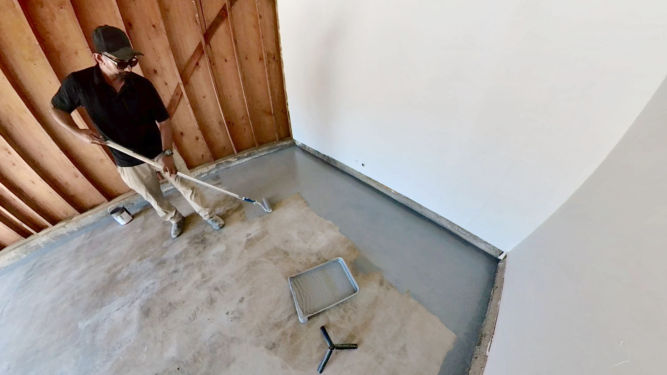
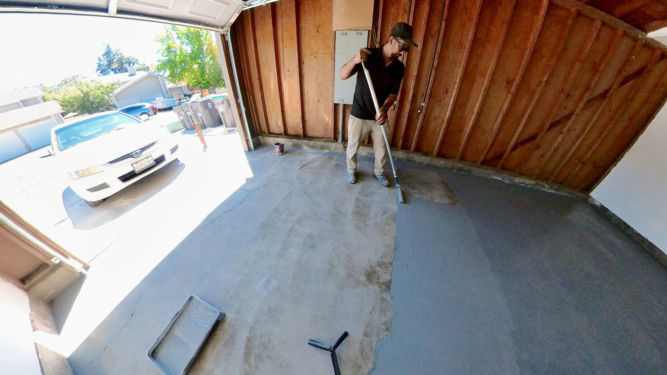
When the epoxy dried, I installed a LED shop light with motion detection.

In one of the other garages (the triplex has 3 garages), I tried applying Behr Granite Grip. Not only is Granite Grip more expensive, I had to use a texture sprayer connected to an air compressor to get good results.

I then had to use a texture roller to even out the material. The results were good but not worth the time, effort and cost for a rental property.

Resurfaced the backyard concrete
The tenants I kicked out had a dog they never cleaned up after. There was dog shit everywhere. When they left, they removed the large pieces but the concrete was still discolored by dog shit that baked in the Stockton, California sun and permeated into the porous concrete. This was brand new concrete that I had put in the year before. Pressure washing with a high-PSI commercial pressure washer was inadequate. I decide to apply the same treatment I applied to the heavily stained garage floor. In this photo, I was etching (scratching) the surface.

I then pressure washed the concrete.

After the concrete dried, I applied epoxy to the joints using a wide paint brush.

And then I rolled on epoxy to the rest of the concrete.

Landscaped the dirt by the fence
When I had the concrete put in, I didn’t want it to go all the way to the fence for drainage purposes. But, if you leave dirt along the fence, you’ll end up with a jungle of weeds, which is exactly what happened. To fix this, I first took used my jack hammer to break up concrete from old fence posts.

I bought a PVC pond liner, which is 14.5-mil thick, and cut it a little longer than some 8-foot-long 2x4s.

I stapled the liner to the 2×4.

I made some holes in the 2×4 and hammered in some long galvanized stakes to hold the wood in place along the edge of the concrete. The pond liner covers some of the dirt. Along the fence, I stapled some pond liner that also covered some of the dirt. In between and overlapping the two pond liner pieces, I put cement board. This will prevent weeds from growing while still allowing water to drain.

Finally, I powered 3/4″ ginger rock to keep everything in place and for aesthetics.

Disposed of all construction debris at the dump
To get rid of all construction debris, I cut up some things into small pieces and put all small garbage in clean-up bags.

I rented a box truck from Home Depot, loaded garbage into a 4-wheel cart, and used it to move junk to the truck.

The process worked very well. Luckily there was a ramp.

At the dump, I threw everything off the edge of the platform like the toilet…

…and the old doors.

Periodically, a huge bulldozer would come and push all the garbage away.

I had to clean the truck to avoid a cleaning fee.

Dumping the many bags of broke tile was extremely tiring. I’ll make sure to pay someone to do that next time.

I paid about $150 to the dump to dispose of a truck-load full of garbage and around $50 for the truck rental.




